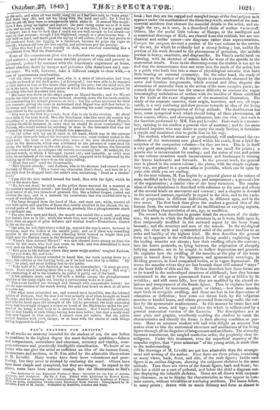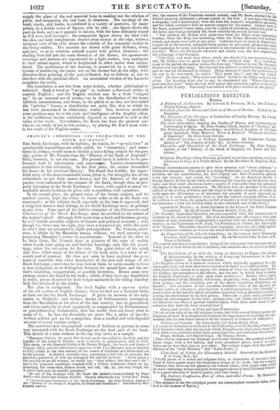PAU'S ANATOMY FOR ARTISTS. * Or all works on anatomy intended
for the student of art, the one before us combines in the highest degree the most desirable qualities,—fulness and compactness, naturalness and clearness, accuracy and vitality, com- prehensiveness and practically intelligible classification. We know of no viater who can give the artist so sufficient an idea of the human frame, its structure and motions, as M. Fau aided by the admirable illustrations of 31. 1.6veiLle. Many works have been more voluminous and pene- trating, but they serve to mislead by confusing the mind. Others have been more simple and synoptical, but they are meagre. In regard to the plates, some have been natural enough, like the illustrations to Bell's The Anatomy of the External Forms of Man : intended for the Use of Artists, Painters, and Sculptors. By Dr. J. Fau. Edited with Additions by Robert Knox, 31.0., Lecturer on Anatomy, and Corresponding Member of the Academy of France. W..ith an Atlas, containing twenty-eight Drawings from Nature: lithographed by M. Levellie, Pupil of AL Jacob. rubllshed by Baillidre, Loudon and Paris. boeltr; but they are.the ragged and mangled image °fate dead subjent as it appears under the mutilations of the dissecting-knife, uncleared of the non- essential accidents that obscure the essential details to the artist, and en- tangle the eye, as it were, in a disordered skein of useless waste-stuff. Others, like the useful little volume of Sharpe, or the intelligent and - symmetrical drawings of Birk, are cleared from this rubbish, but are me- chanical and unlike nature—are diagrams rather than representations- - Cowper the surgeon devoted a portion of his vast volume to the service of the art, for which he evidently had a strong feeling ; but, unlike the portion of his work devoted to the pbmnomena of gestation, the artistio portion is heavy, unartistic, and dia,gramlike. Da Vinci's useful book oil Painting, with its sketches of action, fails for want of the specific in the anatomical details. Even in the dissecting-room the student is too apt to find that the demonstrator does not enter into the needs of the artist, bat is a guide who leads him into a maze of physiological minutim that have little bearing on external symmetry. On the other hand, the study of anatomy on the surface of the living figure is excessively obscured by the outer and formless integuments, which conceal and often disguise the ' alterations of muscular form in the action of the more complex parts; in- somuch that the observer has the utmost difficulty to connect the vague intermingling undulations of surface with the bundles of fibres exhibited by the knife or the exact diagrams of the anatomical illustration. The study of the separate muscles, their origin, insertion, and use, all sepa- rately, is a very confusing and slow process towards an idea of the living movement and the composition of living attitude. The desideratum has been, some synoptical work which should bring all these phamomena, all these causes, effects, and obscuring influences, into one view : and such is the function performed by MAI. Fau and Leveille. .Their work is a master- key, opening to the student a general view of anatomy ; and to the more profound inquirer who may desire to carry the study further, it furnishes a simple and consistent clue to guide him on his way. The student, whether amateur or professional, will understand the ex- cellence of the instrument now placed within his reach, from a brief de- scription of the companion volumes—for they are two. This is in itself a very good arrangement. An octavo size is too small for prints ; a quarto size is inconvenient for reading; and the union of text and prints in one volume occasions much inconvenience and hinderance in turning the leaves backwards and forwards. In the present work, the general text is placed in the octavo volume; the plates, with the simple explana- tory text, are placed in a quarto atlas or portfolio, which can lie open by your side while you are reading.
In the text volume, M. Fau begins by a general glance at the nature of man, modified as he is by climate, race, and temperament ; a general view of the organization; a similar view of the bony structure. The mecha- nism of the articulations is described with reference to the uses and effects of the several kinds on movement and contour ; and a chapter is devoted to the outward contour, especially in regard to the skin, and to the varie- ties of proportion in different individuals, in different ages, and in the two sexes. The first book thus gives the student a general idea of the human form, the essential causes of its modifications or varying aspects, and the leading characteristics of sex, age, or condition.
The second book describes in greater detail the structure of the skele- ton; the mode in which the fleshly structure is, as it were, built upon it, thus reciprocally modified in the outward aspect by the bony frame beneath; and the structure and uses of the muscle. In the myological part, the clear style and symmetrical mind of the author conduce to an order and lucidity of the highest kind. He first describes the general form as it appears in the well-developed living model ; explaining bow the leading muscles are situate ; how their swelling affects the contour ; how the bones protrude, or, lying between the origination of abruptly bellying muscles, are to be sought in hollow depressions and grooves. He explains how the swelling of the muscles or the play of the looser parts is bound down by the ligaments and aponeurotic coverings, in dividing grooves, in fixed compacted bodies, or in vague depressions. He traces the muscles where they are lost beneath these stiff natural "stays" or the laxer folds of skin and fat. He then describes how these forms are to be traced in the undeveloped structure of childhood; how they become caricatured in the more pronounced forms of old age or hidden by its wrinkles ; and still more fully, how they are modified by the altered re- lations and temperament of the female figure. Then he explains how the forms are altered by movement, gentle or violent,—how these muscles start forth in energetic swelling, and those are lost in the depressions of relaxation or deflection; how some are thrust forth by the subjacent muscles or bended bones, and others prevented from rising under the sur- face by the aponeurotic confinements. In this manner he treats face and head, trunk, arms, and legs; and then the whole is reillustrated by a general anatomical version of the Laocoffn. The descriptions are at once plain and graphic, excellently enabling the student to catch the characteristics and identify the forms in their altering condition or pos- ture. Many an amateur student will hail with delight an account that makes clear to him the anatomical structure and mechanism of the living figure through all its disguises of integuments and accidents. The obscurity becomes translucent, the tangled confusion order, the perplexity clear in-
telligence. Under this treatment, even the superficial anatomy of the scapular region, that "pons asinorum" of the young artist, is made clear to the understanding. The drawings of M. lAveill6 are not less admirable than the arrange- ment and writing of the author. First there are three prints, containing as many views, back, front, and side, of the male figure; beside each figure is an outline diagram, showing time subjacent skeleton in the same attitude. Then there are views of the female figure, bank and front ; be- side her a child on a sort of pedestal, and below the child a diagram out- line displaying the infantile skeleton. These are all drawn with surpass- ing clearness, so as to display the characteristics as they appear in eottl- mon nature, without trivialities or confusing accidents. The bones follow, in many prints ; drawn with so much delicacy and force as almost to supply the place of the real material bone in making out the relation of parts, and surpassing the real bone in clearness. The myology of the head, trunk, and limbs, is exhibited in a variety of postures, by many prints, in a double series of figures, side by side : one figure shows the part (a limb, say) as it appears in nature, with the bone delicately traced as if it were seen through ; the companion figure shows the limb with the skin and fatty integuments cleared away except at the edge, where a sectional view of the skin shows the relation of the muscular outline to the living outline. The muscles are drawn with great delicacy, force, and tact, so as to combine natural aspect with perfect clearness : the shading lines fall into the main direction of the fibres; the aponeurotic coverings and tendons are represented by a light surface, very analogous to their actual aspect, which is heightened in effect rather than carica- tured. The perfectness of the drawing is preserved by a very skilful system of numbering the parts, not on the surface but at the edge, with direction-lines pointing to the part indicated, but so delicate as not to interfere with the pictorial effect. Au anatomical version of the Laocotin completes the series.
The translation is not free from some defects, whether philological or technical. Such a word as " m6plat" to indicate a flattened surfac:: is scarcely English ; and the English student may be a little "tripped up" by an unusual use of terms,—as in the distribution of the terms ischium, innominatum, and ileum, in the pelvic or as they are here called the " pelvian" bones; a distribution not quite like that to which he has been accustomed in elementary works. Nor, however creditable some portions may be to the taste and intelligence of the English editor, is the additional matter sufficiently digested or matured to add to the value of the work. Nevertheless, Dr. Knox has done the greatest ser- vice to the study of art in this countty, by placing Dr. Fau's book with- in the reach of the English reader.



























 Previous page
Previous page